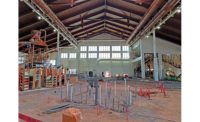"Site constraints were about as challenging as we've ever encountered, given the need to maintain traffic both on Wacker Drive and along the river," Chaves says. As with concrete pours, CDOT closed portions of Wacker during evening hours to stage deliveries of construction equipment and materials.
It was largely up to Walsh and the project's engineers "to keep crews working and out of each other's way," says Chaves, who notes the task entailed choreographing the movements and locations of barges. "Their sizes varied," says Gross, "but at a minimum we had a larger and smaller one in each of the bays where we were building out into the river."
Prior to driving sheet piles and H piles, divers again were recruited "to account for the locations of tunnels, cabling and other subsurface facilities," says Benesch project manager Kurt Knaus.
As operations proceeded, crews employed hydraulic hammers to pound crane-held H-piles into riverbed at 10-ft intervals. After pile drivers drove steel sheet into riverbed, workers installed steel tie-rods and walers to stabilize the emerging wall.
Upon completing operations, workers pumped water out of the 25-ft gap between dockwalls and river walls, then deployed crane-held clamshell buckets to backfill spaces with tons of crushed aggregate.
"Operations required several large pumps, both on barge and landside, to dewater those spaces," says Gross. Divers simultaneously extended intake and drainage pipes from dockwall through sheet pile so river water could continue serving the mechanical systems of surrounding buildings. They also laid new electrical and plumbing conduit in support of new lighting and commercial uses for Riverwalk.
Next came extensive concrete pours to construct pile caps and other structural elements, including a deadman extending between old and new river walls.
Now that phase two is nearing completion, "there's a sense of excitement about all the opportunities Chicagoans will have to experience the river," says Chaves. In addition to themed spaces, visitors will encounter bicycle paths, benches, recreational spaces and sustainable native plant landscaping to support habitat protection. "It's not every day you're provided the opportunity to create land," says Chaves, "or put it to these types of uses."





